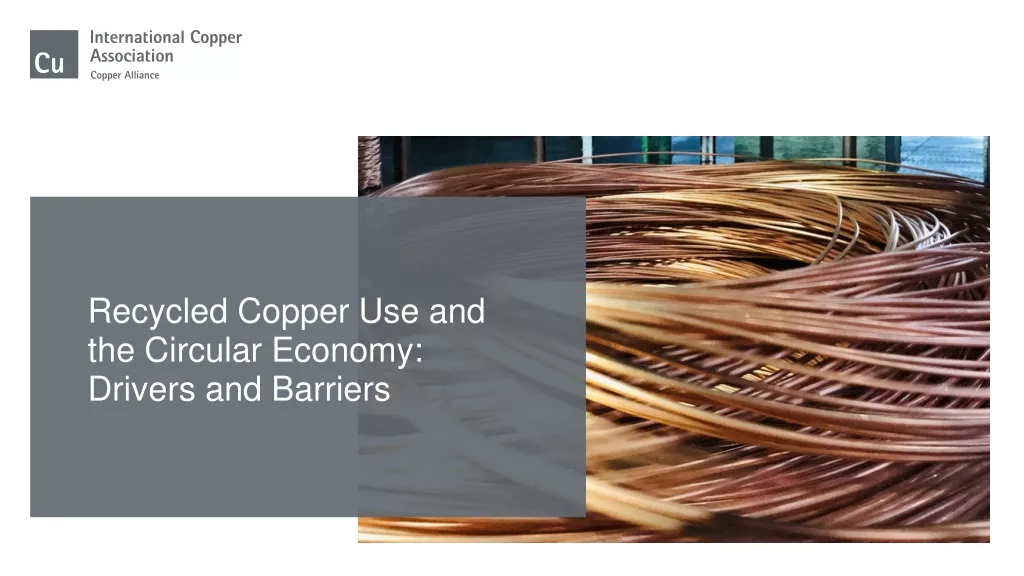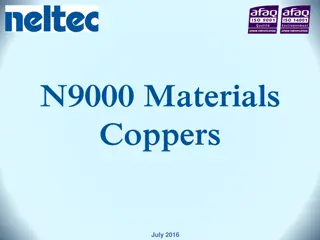Properties and Applications of Copper Alloys
Copper and copper alloys are essential materials due to their excellent properties like ductility, malleability, high conductivity, and corrosion resistance. Various types of copper alloys such as brasses are widely used in electrical conductors, utensils, coins, and industrial applications. Understanding the composition and properties of different copper alloys helps in selecting the right material for specific applications.
Download Presentation

Please find below an Image/Link to download the presentation.
The content on the website is provided AS IS for your information and personal use only. It may not be sold, licensed, or shared on other websites without obtaining consent from the author.If you encounter any issues during the download, it is possible that the publisher has removed the file from their server.
You are allowed to download the files provided on this website for personal or commercial use, subject to the condition that they are used lawfully. All files are the property of their respective owners.
The content on the website is provided AS IS for your information and personal use only. It may not be sold, licensed, or shared on other websites without obtaining consent from the author.
E N D
Presentation Transcript
Unit 5 Non ferrous metal and alloys Visit for more Learning Resources Visit for more Learning Resources
Co related to chapter Select suitable non metals for particular applications as per properties.
Copper and copper alloys Properties of copper 1)it has good ductility and malleability because of its fcc structure. 2) It has high electrical and thermal conductivity. 3) It is non magnetic and has pleasing reddish color. 4)It has an ability of getting alloyed with many other metals which helps in improving its properties. 5)It has fairly good corrosion resistance to general atmospheric conditions.
Application of Copper 1) It is widely used for electrical conductors, bus bars, automobile radiators, roofing, pressure vessels, kettles, utensils, coins and other application. 2) Copper containing about 0.3% arsenic is called arsenical copper and used for condenser, heat exchanger and similar application because of its improved corrosion resistance. 3) Copper containing about 0.6% tellurium is called free cutting copper because of its excellent machinability and it is used for bolts, studs, welding tips and electrical parts such as contact pins, switch gear, relay etc.
Copper alloys Brasses Brasses are the alloys of copper and zinc. Brasses are classified as follows 1) brasses 2) - brasses 3)Red brasses and yellow brasses. brasses contain zinc less than 30% and - brasses Contain zinc between 30 to 44%. Below 20% zinc, color of brasses is red and above 20% zinc, the color is yellow.
Copper alloys 1) brasses Composition: Zinc less than 30% Properties: Ductile, soft, malleable and fairly good corrosion resistance. Application: Cold rolling Wire drawing Press work.
Copper alloys A) Cap copper: Composition: zinc between 2 to 5%. If zinc is not added ,copper oxide present in the structure reduces ductility and malleability. Properties: cap copper is very ductile. Application: used as cap detonators in ammunition factories. B)Gilding metal: Composition: zinc from 5 to 15%.
Copper alloys Application: bullet envelopes, drawn containers, condenser tubes, coins, needles, emblems and dress jewelry because of color like gold. c)Cartridge brass: Composition: about 30% zinc. Properties: maximum ductility and malleability amongst all the brasses. Application: for forming by deep drawing, stretching, trimming, spinning and press work operations. It is also used for cartridge cases, radiator fins, lamp fixture, rivets and springs.
Copper alloys D) Admiralty brass: Composition: about 1% tin is added to cartridge brass to improve the corrosion resistance and such a brass is called as admiralty brass. 22% Zn, 2% Al and about 0.04% As. Application: condenser tubes and heat exchanger in steam power plant. Marine application.
Copper alloys - brasses: Composition: zinc between 32 to 40% Properties: hard, strong and are fabricated by hot working processes , more ductile and malleable, cheap, poor corrosion resistance. A) Muntz metal Composition: 40% zinc with balance copper. Properties: this becomes single phase at about 700c. It can be readily hot worked , extruded or rolled in temp. range of 600 to 800c.
Copper alloys Tensile strength of 35 to 40% kg/mm2. Hardness of 100 to 120 v.p.n. Application: utensils, shaft, nuts and bolts, pump parts, condenser tubes . B) Naval brass: Composition: 1% tin to Muntz metal increases corrosion resistance to marine environment and brass is called as naval brass or Tobin bronze. Application: marine hardware, propeller shaft, piston rods, nuts and bolts and welding rods.
Copper alloys c)Leaded brass: composition: lead is added in small amount (1 to 3%) to improve machinability of brasses. Properties: addition of lead is done to both the muntz metal and naval brass for improvement of machinability. This results in slight decrease in ductility and impact strength of the alloys. D) High tensile brasses: Composition: Alloying elements such as Al, Fe, Mn, Sn and Ni are added to 60-40 brass(Muntz metal) to increase its tensile strength.
Copper alloys Brass containing two or more above element is called as high tensile brasses. One of its manganese bronze containing up to 1% Mn, 2% Fe, 39% Zn and balance copper. It has good sea water resistance, tensile strength of 40- 55 kg/mm2 and elongation of 20 to 30%.. Application: marine engine pumps, ship propellers, gears, valve bodies.. E)Brazing brass: Composition: brass with 50-50 composition is used for brazing purpose. Property: brittle.
Bronze Bronze are the alloys of copper containing elements other than zinc. In these alloys , zinc may be present in small amount. Originally the name bronze was used to denote copper- tin alloys. Commercially important bronzes are aluminum bronzes, tin bronzes, beryllium bronzes and silicon bronzes.
Aluminium Bronze Composition: copper + aluminum Commercial aluminium bronzes contain 4 to 11% aluminium. Other elements such as Fe, Ni, Mn and Si may be added too these bronzes for improvement of certain properties. Properties: Good strength, ductility, toughness. Good bearing properties. Good corrosion resistance. Good fatigue resistance. Applications: jewelry, cigarette cases, heat exchangers, chemical plants, pump castings, valve fittings, propellers, cylinder heads, gears, dies, bearings, spark plug bodies and electrical contacts.
Tin Bronze Composition: tin + copper Classification: A)Alloy up to 8% tin: Good ductility, malleability, good corrosion resistance. They can be easily cold worked and hence are used in the form of sheets, wires and coins. B)Alloy between 8 to 12 % tin: Used for pumps, gears, heavy load bearings and marine fittings to resists sea water corrosion. c)Alloy between 12 to 20% tin: They are mainly used for bearings.
Tin Bronze D)Alloy between 20 to 25% tin: They are principally used for bells and are called as bell metal. Very hard and brittle, and give ringing sound. Gun metal: It contain about 10 % tin and 2% zinc. It is widely used for gun barrels and ordnance parts, marine castings, gears, bearings, valve bodies and similar applications.
Beryllium bronze Solubility of beryllium in copper is 2.1 % at 864c and decreases with decreasing temp. Properties: Tensile strength 130 to 140 kg/mm2 Hardness 350 BHN Good corrosion resistance, good fatigue resistance, high resilience and good bearing properties Low elastic hysteresis and non sparking characteristics. Application : springs, diaphragms, flexible bellows, gears, bearing and certain tool like hammers. Also used for electrical contacts and moulds for forming of plastics.
silicon bronze The alloy of silicon and copper is called as silicon bronze. Properties: High resistance to corrosion, High tensile strength, Cold working, hot working, casting, good machinability High toughness. Application : High strength bolts, rivets, springs, propeller shafts and bells. They are produced in the form of strips, plates, wires, rods, tubes, pipes, and castings.
Copper nickel alloys Properties: Ductile, malleable and can be worked both in cold and hot conditions. The corrosion resistance increases with increase in nickel. Tensile strength, fatigue strength increases with nickel. Application : It is used as resistor . Used for thermocouple wires, locomotive fire boxes as stay rods, Marine condensers, turbine blades, bullet envelopes and coins, resistance wire, valve parts, pump rod liners, impellers and part in chemical industry, rivets, screws, table flatware, costume jewelry, name plates, radio dials, camera and optical parts.
Aluminium and aluminium alloys Properties: It is ductile and malleable due to fcc structure. It is light in weight. Good thermal and electrical conductivity, It has excellent corrosion and oxidation resistance. Corrosion product of aluminium is non toxic . It remains ductile and tough up to -40 c. Non magnetic, non sparking in character. It has excellent ability of getting alloyed with other elements. Application : Cooking utensils, combs, collar buttons, toasters, mixers,
Aluminium and aluminium alloys electrical conductors, food containers, paint, name plates, ash trays, flower pots, coins , bicycles, motorcycles, trucks, and buses, aero planes, and marine vessels.
Y-alloys(LM 14) Composition: This is high strength aluminium alloy and contains about 4% copper, 2% nickel and 1.5% magnesium. Properties: It has excellent ability to retain the strength at elevated temp. with fairly good corrosion resistance. It can be easily cast and rolled, but it is chiefly used in the cast form. Application: It is mainly used for pistons and cylinders heads of diesel and high duty petrol engines.
Hinduminium (RR 350) Composition: 5% Cu and 1.5 % Ni with small amount of Mn, Ti, Sb, Co and Zr. Property: creep resistance Application: aero engine. Duralumin: 4.5% Cu+ magnesium(0.5%) +manganese (about 0.5%) . Good strength Shock resistance Corrosion resistance Application : air craft castings.
Bearing materials properties: The friction between the bearing and the rotating shaft should be minimum. It should be hard and wear resistance and longer life. It should have sufficient load bearing ability. It should have sufficient plasticity. It should have high fatigue resistance It should have good thermal conductivity. It should have very low or very high melting point It should have oil retaining capacity Good corrosion resistance, cheap, readily available.
Bearing materials White metal ( Babbitts ): Babbitts are either lead based or tin based alloys. Pb based: 1-10% Sn, Pb- balance, 10-15%Sb, 1.5-3.5%Cu,( others 1.25-1.75%Cd, as0-1%) Sn based: Sn balance, Pb up to 10%, Sb 5-12%, Cu 3-5%(others As: 0-0.1%) properties: corrosion resistance, Wear resistance, Costly Lead is added to theses Babbitts to reduce their cost. Application: lorry diesel engine crank shafts.
Bearing materials Copper lead alloy Copper lead bearings are widely used in automotive and aeronautic applications. These alloy contain lead in the range of 20 to 40 % with small amount of tin. Other bearing materials Silver bearing Tin bronze Aluminium alloys Gray cast iron
Porous self lubricating bearing. These bearings are manufactured by powder metallurgy. Porous bearings are made from copper or iron base powders with as much as 40 to 50 % porosity. And are impregnated with oil. During the use , oil from the pores slowly comes out and forms a lubricating film on the moving surface. When working is stopped , the oil goes back to the pores by capillary action. They do not require any external lubrication and hence called as self lubricating bearings. Cu(90%) Sn(10%) graphite and Fe(96%) bearing are widely used as self lubricating bearing. For more detail contact us For more detail contact us























